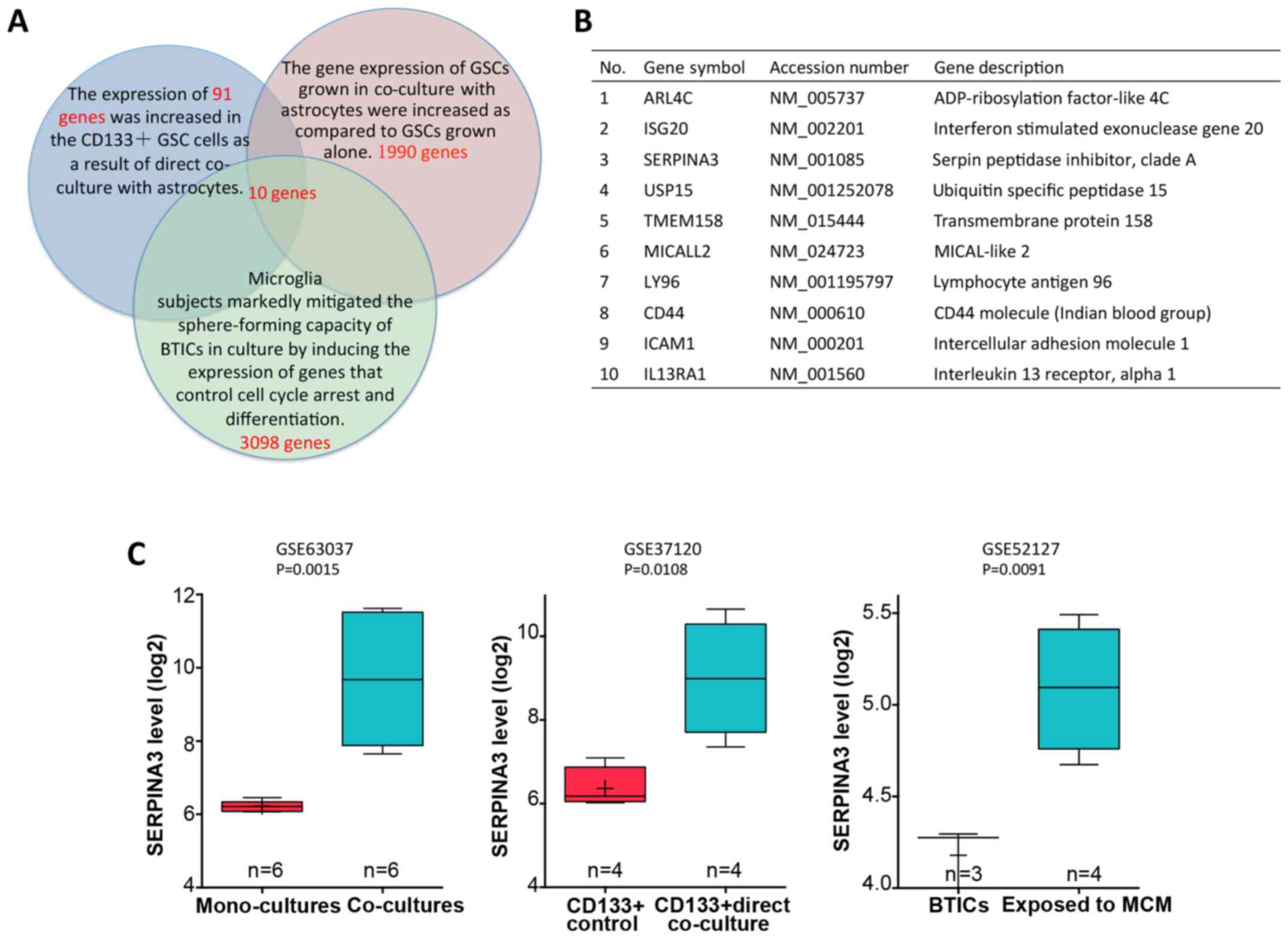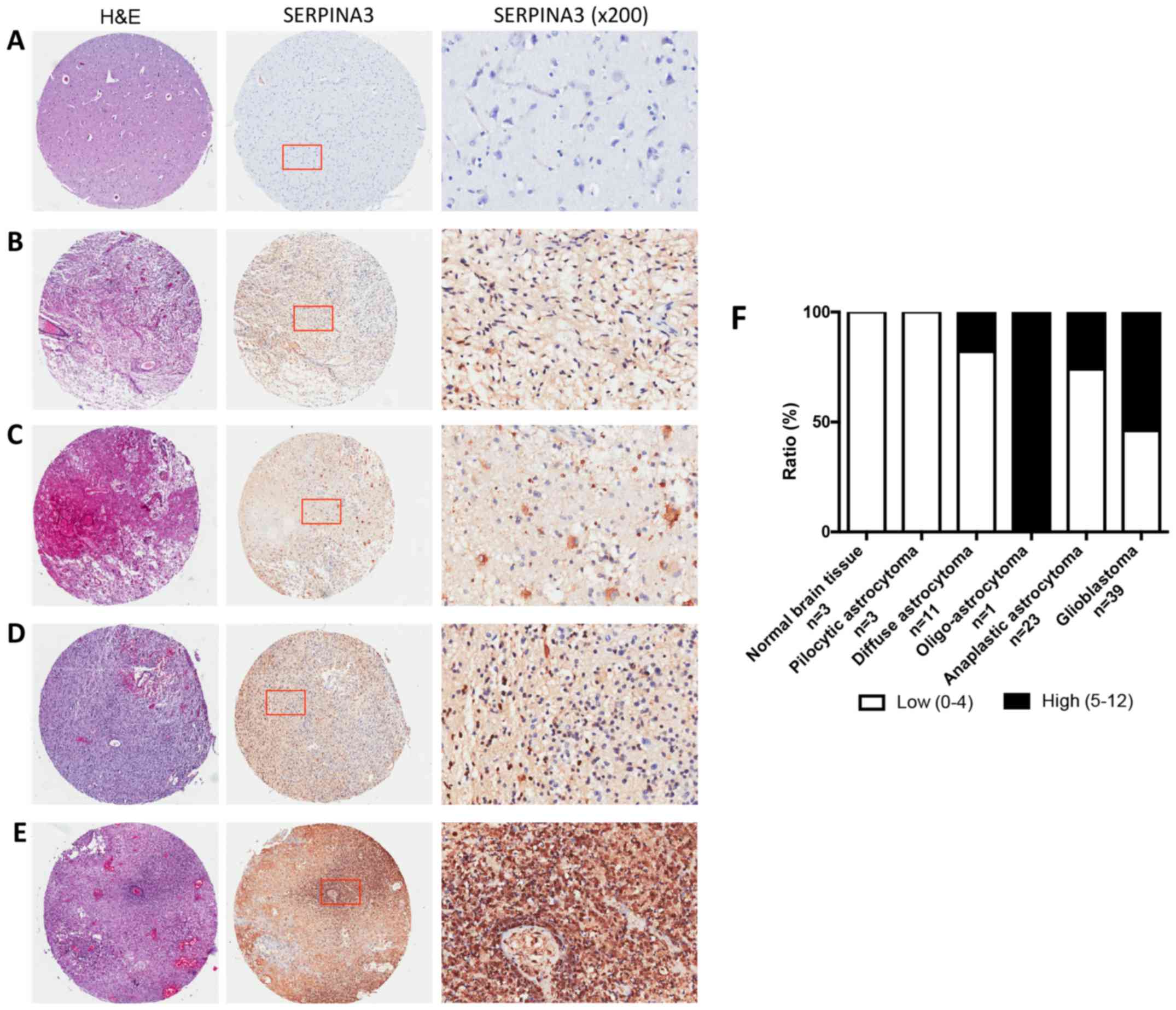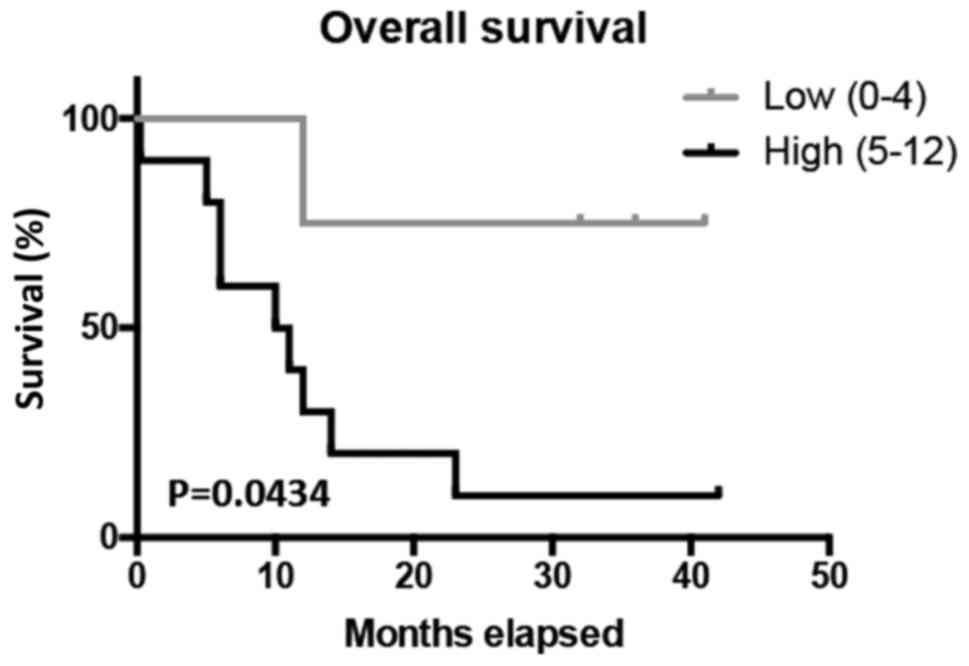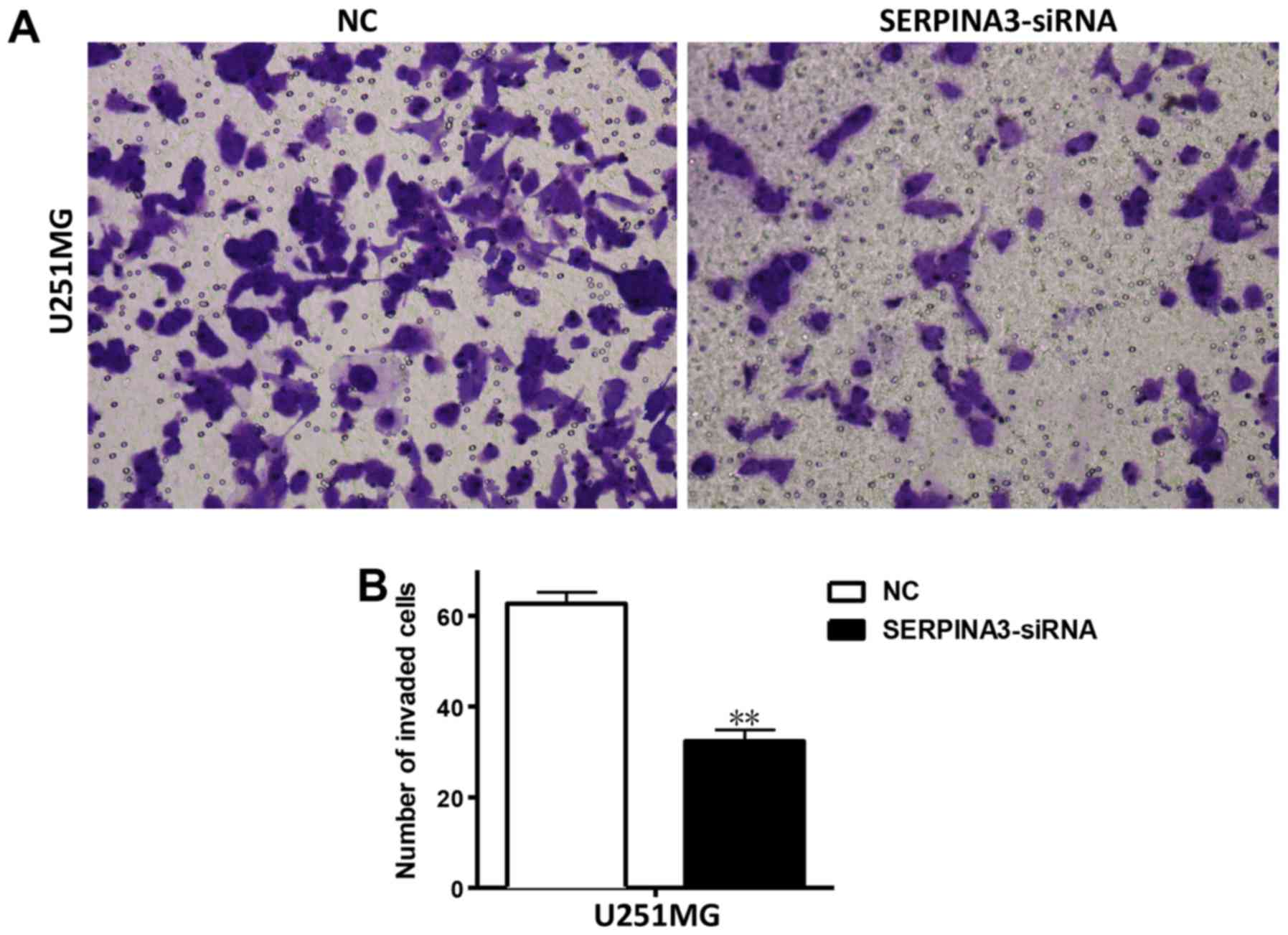SERPINA3 induced by astroglia/microglia co‑culture facilitates glioblastoma stem‑like cell invasion
- Authors:
- Published online on: October 26, 2017 https://doi.org/10.3892/ol.2017.7275
- Pages: 285-291
-
Copyright: © Li et al. This is an open access article distributed under the terms of Creative Commons Attribution License.
Abstract
Introduction
Gliomas are the most common primary brain tumors in adults (1). The most malignant form, glioblastoma (GBM), is resistant to current standard treatment, and the current 5-year overall survival of grade IV GBM patients using radiotherapy with concomitant TMZ treatment is only 9.8% (2). Data now suggest that GBMs are driven and maintained by a rare population of stem-like transformed cells that undergo self-renewal known as Glioblastoma stem-like cells (GSCs) (3). In addition to their stem-like capacity to proliferate, GSCs contribute to the malignancy of GBMs by their relative resistance to radiotherapy (4) and chemotherapy (5), in contrast with their differentiated, transformed form. Moreover, when implanted in immunodeficient mice, GSCs form a highly invasive and phenotypically heterogeneous brain tumor (6).
It is increasingly apparent that crosstalk between cancer cells and cells of the neoplastic stroma is involved in the acquired capability for invasive growth and metastasis (7). It has been generally assumed that GSCs should also play a major role in determining GBM invasion into normal brain tissue. Some studies have reported that normal brain cells influence GBM invasion behavior (6,8). Rath et al reported that under co-culture conditions, astrocytes significantly enhance the invasion capacity of GSCs, but not of non-GSCs (6). Therefore, understanding the molecular profile of surrounding glioma cells co-cultured GSCs could help us explore the underlying regulators that control the GSCs invasion in tumor microenvironment (TME).
To identify the regulators of GSCs invasion in TME, we carried out an integrative analysis to identify genes that are important for GSC invasion and are specifically upregulated in astroglia/microglia co-cultured GSCs. Among the genes identified, serpin peptidase inhibitor clade A member 3 (SERPINA3) was found to be abnormally overexpressed in astroglia/microglia co-cultured GSCs. SERPINA3 is a 55–66 kDa secreted serine protease inhibitor that proteolytically inhibits the activity of several serine proteases including chymotrypsin and cathepsin G (9,10). SERPINA3 is an acute phase protein and its gene expression is stimulated by the presence of cytokines (10). SERPINA3 is involved in a wide range of physiological activities such as inflammatory response (11), complement activation (12), regulation of lipid metabolic process (13), apoptosis, and wound healing (10). Recently, upregulated SERPINA3 expression has been reported in multiple cancer types (14–16), and high SERPINA3 expression has been demonstrated to positively correlate with poor prognosis in patients with colon (14), breast (15), lung (17,18), and gastric cancers (19).
To further investigate the role of SERPINA3 in glioma pathogenesis and prognosis, we used tissue microarray (TMA) containing 80 lesions (including 3 normal brain, 3 pilocytic astrocytomas, 11 diffuse astrocytomas, 1 oligodendrocytes astrocytoma, 23 anaplastic astrocytomas, and 39 glioblastomas multiforme samples) and immunohistochemistry (IHC) analysis to evaluate the expression of SERPINA3 and its relation to clinicopathologic factors and patient survival. Our data indicated that upregulation of SERPINA3 was significantly associated with glioma progression and worse patient survival. RNAi-mediated silencing of SERPINA3 expression in cultured glioma cell lines resulted in significant cell matrix invasion. These results suggest that SERPINA3 may play an important role in glioma progression.
Materials and methods
Cell culture
Human GBM cell line U251MG was obtained from the RIKEN Cell Bank (Tsukuba Science City, Japan). U251MG was cultured in Dulbecco's modified Eagle's medium (DMEM; Life Technologies, Rockville, Maryland, USA) supplemented with 10% (v/v) fetal bovine serum.
GEO data sets analysis
Gene expression data (GSE63037, GSE37120, GSE52127 profiling data) were downloaded as raw signals from Gene Expression Omnibus (http://www.ncbi.nlm.nih.gov/geo), interpreted, normalized and log2 scaled using the online analysis tool GCBI website (https://www.gcbi.com.cn). Exploring of differentially expressed gene sets between GSCs and astrocyte/microglia co-cultured GSCs profiles in GSE63037, GSE37120 and GSE52127 was also performed via the GCBI online tool.
TMA analysis
The glioma TMA containing 77 glioma clinic samples of different grades with survival time were purchased from Shanghai Outdo Biotech Company (Shanghai, China). Shanghai Outdo Biotech Company is a daughter company of Shanghai Biochip Co., Ltd., which is also the National Engineering Center for Biochip Design and Engineering in Shanghai. The TMA consisted of 3 normal brain, 3 pilocytic astrocytomas, 11 diffuse astrocytomas, 1 oligodendrocytes astrocytoma, 23 anaplastic astrocytomas, and 39 glioblastomas multiforme samples. The tissue samples on the TMAs that we used in this study were collected from Tai Zhou hospital of Zhejiang province, China. All the patients had given informed consent and the collection of tissue samples for research was approved by the Ethics Committee of Tai Zhou hospital in January 26, 2010.
IHC staining of TMA
The IHC assay using SERPINA3 was performed as described (20). Briefly, the slides were first deparaffinized, followed by blocking with 30% normal donkey serum for 10 min. Then the sections were incubated overnight with the primary SERPINA3 rabbit monoclonal antibody (dilution 1:500, Rabbit monoclonal to SERPINA3, clone ab180492; Abcam Corp., Cambridge, UK) at 4°C. The slides were incubated with biotinylated secondary antibody for 30 min and then the slides were incubated for 30 min with streptavidine-peroxidase. Staining development was performed with 3–3′-diaminobenzidine. Negative controls were carried out by replacement of the primary antibody with substituting phosphate buffer saline. The specimens were analyzed under a light microscope (Nikon, Tokyo, Japan) by pathologists.
Quantification of SERPINA3 staining intensity and statistic analysis
A previously described (21) 4-point scoring system was used to determine intensity of SERPINA3 staining. Scoring was performed by three independent scorers, including a pathologist, without access to clinicopathological information of the sections. Discrepancies among the scorers were resolved by obtaining a consensus score, whereby the group evaluated the sections simultaneously using scanned microscope images. Section staining was evaluated using the 12-point Remmele scale (22). Briefly, staining intensity was scored as 0 (negative), 1 (weak), 2 (moderate) and 3 (strong). For each sample, five high-power fields (magnificattion, ×200) were randomly selected. Cytoplasmic and membranaceous staining intensity and percentage of positive tumor cells were assessed. The percentage of SERPINA3 expressing cells was scored into four categories: 1 (0–25%), 2 (26–50%), 3 (51–75%) and 4 (76–100%). In the cases with a discrepancy between duplicated cores, the higher score from the two tissue cores was taken as the final score. The level of staining was evaluated by immunoreactive score (IRS), which is calculated by multiplying the scores of staining intensity and the score of the percentage of positive cells. Based on the IRS, SERPINA3 staining pattern was defined as weak (IRS: 0–4) and strong (IRS: 6–12).
Transwell invasion assay
Transwell invasion assay was performed using the 24-well cell culture inserts pre-coated with a growth factor-reduced Matrigel layer to mimic basement membranes (8 µm pore; BD Bioscience, San Jose, California, USA). A total of 500 µl DMEM with 10% fetal bovine serum was added to the lower chamber. U251MG cells were trypsinized 24 h post siRNA transfection and plated in the upper chamber and allowed to invade for 24 h at 37°C. The target short interfering RNA (siRNA) sequences of SERPINA3 are: 5′-AAGGACCATTGTGCGTTTCAA-3′. After the allotted time, the lower side of the Transwell insert was carefully washed with cold PBS and non-invading cells remaining on the top chamber were removed with a cotton tip applicator, and then the membranes were fixed with methanol and stained with crystal violet. The number of invading cells was determined by averaging cell counts from nine randomly selected fields (magnification, ×100).
Statistical analysis
Statistical analysis was performed with GraphPad Prism 5 software (GraphPad Software, San Diego, CA). Differences in SERPINA3 staining in the various stages of glioma were evaluated using chi-squared (χ2) analysis. Kaplan-Meier survival time analysis was used to estimate the survival time distributions, and the log-rank test was used to assess the statistical significance between different groups.
Results
Overexpression of SERPINA3 in astrocyte/microglia co-cultured GSCs
To investigate the mechanisms through which TME enhances GSC invasion, we carried out an integrative analysis to identify genes that are important for GSC invasion and specifically upregulated in astrocyte co-cultured GSCs. Herein, we identified a cluster of 91 genes that were highly expressed in CD133+GSC cells as a result of direct co-culture with astrocytes in dataset GSE37120. To achieve this, we analyzed the overlapping genes with the calculated 1990 genes that were significantly upregulated in GSCs grown in co-culture with astrocytes in GSE63037 and 3098 genes that were highly expressed in brain tumor-initiating cells after exposure to microglia conditioned medium (MCM) in GSE52127. We identified 10 genes as candidate targets for GSC invasion (Fig. 1B). Among the genes identified, SERPINA3 was selected for further study due to its reported role in regulating melanoma migration and invasion and its capacity as a prognostic factor in many cancers (14,17,23). To the best of our knowledge, the role of SERPINA3 on GSC invasion has not been well studied. Normalized expression of SERPINA3 in GSCs vs. astrocyte co-cultured GSCs or BTICs vs. BTICs exposed to MCM are shown in Fig. 1C.
Increase of SERPINA3 expression correlates with glioma progression
To further investigate the role of SERPINA3 in glioma pathogenesis and prognosis, we used TMA containing 80 melanocytic lesions (including 3 normal brain, 3 pilocytic astrocytomas, 11 diffuse astrocytomas, 1 oligodendrocytes astrocytoma, 23 anaplastic astrocytomas, and 39 glioblastomas multiforme samples) and IHC to evaluate the expression of SERPINA3 and its relation to clinicopathological factors and patient survival. The demographics and clinicopathological characteristics of glioma patients are shown in Table I. There were 77 glioma patients with age ranging from 21 to 75 years (median age is 53 years). According to the American Joint Committee on Cancer (AJCC) staging system, 3 and 14 cases were Stage I and II, respectively, while 24 and 36 cases were Stage III and IV, respectively (Table I).
To investigate the expression level of SERPINA3 in the biopsies of pigmented lesions, we performed IHC staining of normal brain, pilocytic astrocytomas, diffuse astrocytomas, oligodendrocytes astrocytoma, anaplastic astrocytomas, and glioblastomas multiforme samples on TMA slides (Fig. 2A-E). The staining was predominantly in the cytoplasm, therefore, only cytoplasmic staining was evaluated. IHC results demonstrated that 0% of normal brain tissue and 0% of the pilocytic astrocytomas vs. 26% of anaplastic astrocytomas and 54% of the glioblastomas multiforme samples showed high SERPINA3 immunostaining. Strikingly, we found marked increase of SERPINA3 expression in glioblastomas multiforme compared with normal brain and pilocytic astrocytomas (P=0.0484, χ2 test). A further increase was observed in glioblastomas multiforme compared with anaplastic astrocytomas and diffuse astrocytomas (P=0.0332 and 0.0361, respectively, χ2 test) (Fig. 2F).
In the 77 glioma cases, we found that high SERPINA3 expression ratio was significantly increased from 18% in early AJCC Stage (I + II) to 45% in Stage (III + IV) (P=0.0412, χ2 test). Interestingly, we also observed stronger staining of SERPINA3 in older patients compared to younger subjects (P=0.0002, χ2 test). This reason for disparity in SERPINA3 expression levels based on age is largely unknown and worth further investigation. We did not detect significant correlations between SERPINA3 expression and sex (Table I).
SERPINA3 expression in glioma biopsies is correlated with poor patient survival over 5 years
In order to determine the prognostic value of SERPINA3, Kaplan-Meier survival tests were conducted for the 5-year overall survival of GBM patients. The analysis revealed that patients with high SERPINA3 expression had significantly lower 5-year overall survival (P<0.0434) (Fig. 3). Patients with higher SERPINA3 expression had a survival rate of approximately 10%, while patients with lower SERPINA3 expression have a survival rate of approximately 75%. Data are presented in this study using all GBM cases; however, future studies will strive to clarify the correlation between SERPINA3 expression and survival at all stages.
SERPINA3 promotes glioma invasion in extracellular matrix (ECM)
An in vitro Matrigel invasion assay was conducted to examine the effect of SERPINA3-knockdown on cell invasion. Matrigel is a semi-solid protein mixture that closely mimics the ECM. As shown in Fig. 4, the siRNA-mediated inhibition of SERPINA3 significantly reduced the invasion of U251MG cells (Fig. 4).
Discussion
The potential contribution of GSCs to the invasive phenotype of GBM has not been clearly defined. Invasion is a complex process involving interactions among normal cells, tumor cells, and the ECMs (6,24). During invasion, GBM cells interact with a variety of surrounding glioma cells. In recent years, many studies have been reported that surrounding glioma cells are associated with brain cancer progression (6,25,26). Among such surrounding glioma cells, astrocytes are the most frequent non-neuronal cell type comprising approximately 50% of the human brain volume, and have been shown to play a major role in the maintenance and remodeling of the brain ECM (27). Besides astrocytes, other surrounding glioma cells in situ are microglia, which are innate immune cells intrinsic to the CNS. Microglia comprise a substantial portion of the tumor mass, with some estimates being as high as 1 in every 3 cells (26,28).
In an attempt to better define the processes and molecules mediating GBM cell invasion within the TME, we carried out an integrative analysis to identify genes that are important for GSC invasion and specifically upregulated in astroglia/microglia co-cultured GSCs. Three data sets were used (GSE63037, GSE37120 and GSE52127) for this purpose. Gene expression profiles were generated from GSC in mono-culture vs. 48 h after co-culture with astrocytes for dataset GSE63037. In the data set GSE37120, GSCs or their differentiated progeny were co-cultured for 48 h with normal human astrocytes, and the impact on invasion-associated genes was examined. There were 6 groups examined, including GBM CD133+ indirect co-cultured, GBM CD133+ direct co-cultured, GBM CD133+ control, GBM CD133− indirect co-cultured, GBM CD133− direct co-cultured, and GBM CD133− control group. We carried out an integrative analysis between GBM CD133+ direct co-cultured and GBM CD133+ control group, and found that 91 genes were highly expressed in CD133+GSC cells as a result of direct co-culture with astrocytes. In the data set GSE52127, brain tumor initiating cells (BTICs) were subjected to microarray to determine the genes involved in BTICs growth and differentiation when exposed to microglia-conditioned medium (MCM) for 6 h. All the 3 data sets used the platform of Affymetrix Human Genome U133A 2.0 Array. A total of 10 overlapping genes were significantly upregulated within these 3 datasets, we identified SERPINA3 as a candidate target for enhancing the invasion potential of GSCs.
SERPINA3 is a serpin peptidase inhibitor, and has been reported to be overexpressed in many tumor types (17–19,23), indicating a potential role in tumor progression. Proteolytic degradation of the ECM is considered an essential step in the invasion and metastasis of malignant cells to distant tissues (29,30), and proteases, such as matrix metalloproteinases (MMPs), expressed by neoplastic and/or stromal cells are therefore considered key players in this process. As a consequence, protease inhibitors are intuitively expected to have an anti-malignant role (31,32). SERPINA3 acts as an inhibitor of several serine proteases including pancreatic chymotrypsin, leukocyte cathepsin G, mast cell chymases, human glandular kallikrein 2, kallikrein 3 (prostrate specific antigen), pancreatic cationic elastase, and an uncharacterized lung serum protease (10). The strongest association is found with cathepsin G and is thus thought to be the major target of SERPINA3 (33).
In this study, we examined the expression pattern of SERPINA3 at the various stages of glioma progression, including normal brain, pilocytic astrocytomas, diffuse astrocytomas, oligodendrocytes astrocytoma, anaplastic astrocytomas, and glioblastomas multiforme. SERPINA3 expression levels appeared to strongly correlate with glioma invasion. IHC results demonstrated that 0% of normal brain tissue and 0% of the pilocytic astrocytomas vs. 26% of anaplastic astrocytomas and 54% of the glioblastomas multiforme samples showed high SERPINA3 expression. Furthermore, a significant increase of SERPINA3 expression in glioblastomas multiforme compared with normal brain and pilocytic astrocytomas (P=0.0484, χ2 test), and between anaplastic astrocytomas and diffuse astrocytomas (P=0.0332 and 0.0361, respectively, χ2 test), was observed. In the 77 glioma cases, we found that high SERPINA3 expression ratio significantly increased from 18% in early stage GBM to 45% in late stage disease (P=0.0412, χ2 test). Interestingly, we also observed that SERPINA3 expression was positively correlated with age (P=0.0002, χ2 test). These results indicate that SERPINA3 could play a critical role in glioma initiation and progression process. Kaplan-Meier survival analysis confirmed that patients with high SERPINA3 expression had lower survival rates, indicating possible clinical prognostic value of SERPINA3 in GBM patients.
Serpins have multiple complex roles in tumor biology. Although SERPINA3 has been found to be differentially expressed in multiple tumors, its functional impact on tumor progression remains largely unknown. To further address this question, we performed in vitro analysis on cultured GBM cell lines with siRNA-mediated downregulation of SERPINA3 expression. Not surprisingly, the ability of GBM cells to invade through Matrigel was severely impaired upon downregulation of SERPINA3 expression. Matrigel resembles the complex extracellular environment found in many tissues and is a validated ex vivo model of tissue matrix. It has previously been suggested that SERPINA3 might promote GBM invasion through remodeling the extracellular tissue matrix. Therefore, molecules targeting SERPINA3 may have therapeutic implications for GBM in the near future, although the precise mechanism of how SERPINA3, the serine protease inhibitor, affects the structure of ECM remains to be elucidated.
Acknowledgements
The authors would like to thank Dr Wang Shuhuai for pathological evaluation of SERPINA3 staining in glioma TMA (Department of Pathology, Cancer Hospital of Harbin Medical University, Harbin, 150040, China). The present study was supported by the Foundation of Health and Family Planning Commission of Heilongjiang Province (2016–075).
References
|
Meyer MA: Malignant gliomas in adults. N Engl J Med. 359:18502008. View Article : Google Scholar : PubMed/NCBI | |
|
Chen D, Song M, Mohamad O and Yu SP: Inhibition of Na+/K+-ATPase induces hybrid cell death and enhanced sensitivity to chemotherapy in human glioblastoma cells. BMC Cancer. 14:7162014. View Article : Google Scholar : PubMed/NCBI | |
|
Binda E, Visioli A, Giani F, Trivieri N, Palumbo O, Restelli S, Dezi F, Mazza T, Fusilli C, Legnani F, et al: Wnt5a drives an invasive phenotype in human glioblastoma stem-like cells. Cancer Res. 77:996–1007. 2017. View Article : Google Scholar : PubMed/NCBI | |
|
Bao S, Wu Q, McLendon RE, Hao Y, Shi Q, Hjelmeland AB, Dewhirst MW, Bigner DD and Rich JN: Glioma stem cells promote radioresistance by preferential activation of the DNA damage response. Nature. 444:756–760. 2006. View Article : Google Scholar : PubMed/NCBI | |
|
Eramo A, Ricci-Vitiani L, Zeuner A, Pallini R, Lotti F, Sette G, Pilozzi E, Larocca LM, Peschle C and De Maria R: Chemotherapy resistance of glioblastoma stem cells. Cell Death Differ. 13:1238–1241. 2006. View Article : Google Scholar : PubMed/NCBI | |
|
Rath BH, Fair JM, Jamal M, Camphausen K and Tofilon PJ: Astrocytes enhance the invasion potential of glioblastoma stem-like cells. PLoS One. 8:e547522013. View Article : Google Scholar : PubMed/NCBI | |
|
Hanahan D and Weinberg RA: Hallmarks of cancer: The next generation. Cell. 144:646–674. 2011. View Article : Google Scholar : PubMed/NCBI | |
|
Rath BH, Wahba A, Camphausen K and Tofilon PJ: Coculture with astrocytes reduces the radiosensitivity of glioblastoma stem-like cells and identifies additional targets for radiosensitization. Cancer Med. 4:1705–1716. 2015. View Article : Google Scholar : PubMed/NCBI | |
|
Kalsheker NA: Alpha 1-antichymotrypsin. Int J Biochem Cell Biol. 28:961–964. 1996. View Article : Google Scholar : PubMed/NCBI | |
|
Baker C, Belbin O, Kalsheker N and Morgan K: SERPINA3 (aka alpha-1-antichymotrypsin). Front Biosci. 12:2821–2835. 2007. View Article : Google Scholar : PubMed/NCBI | |
|
Sun YX, Wright HT and Janciauskiene S: Glioma cell activation by Alzheimer's peptide Abeta1-42, alpha1-antichymotrypsin, and their mixture. Cell Mol Life Sci. 59:1734–1743. 2002. View Article : Google Scholar : PubMed/NCBI | |
|
Bodmer JL and Schnebli HP: Plasma proteinase inhibitors. Schweiz Med Wochenschr. 114:1359–1363. 1984.PubMed/NCBI | |
|
Sun YX, Wright HT and Janciauskiene S: Alpha1-antichymotrypsin/Alzheimer's peptide Abeta(1–42) complex perturbs lipid metabolism and activates transcription factors PPARgamma and NFkappaB in human neuroblastoma (Kelly) cells. J Neurosci Res. 67:511–522. 2002. View Article : Google Scholar : PubMed/NCBI | |
|
Karashima S, Kataoka H, Itoh H, Maruyama R and Koono M: Prognostic significance of alpha-1-antitrypsin in early stage of colorectal carcinomas. Int J Cancer. 45:244–250. 1990. View Article : Google Scholar : PubMed/NCBI | |
|
Hurlimann J and van Melle G: Prognostic value of serum proteins synthesized by breast carcinoma cells. Am J Clin Pathol. 95:835–843. 1991. View Article : Google Scholar : PubMed/NCBI | |
|
Lein M, Stephan C, Jung K, Schnorr D and Loening SA: Molecular forms of prostate-specific antigen and human kallikrein 2 as possible indicators in prostatic carcinoma diagnosis. Urologe A. 39:313–323. 2000.(In German). View Article : Google Scholar : PubMed/NCBI | |
|
Higashiyama M, Doi O, Yokouchi H, Kodama K, Nakamori S and Tateishi R: Alpha-1-antichymotrypsin expression in lung adenocarcinoma and its possible association with tumor progression. Cancer. 76:1368–1376. 1995. View Article : Google Scholar : PubMed/NCBI | |
|
Zelvyte I, Wallmark A, Piitulainen E, Westin U and Janciauskiene S: Increased plasma levels of serine proteinase inhibitors in lung cancer patients. Anticancer Res. 24:241–247. 2004.PubMed/NCBI | |
|
Tahara E, Ito H, Taniyama K, Yokozaki H and Hata J: Alpha 1-antitrypsin, alpha 1-antichymotrypsin, and alpha 2-macroglobulin in human gastric carcinomas: A retrospective immunohistochemical study. Hum Pathol. 15:957–964. 1984. View Article : Google Scholar : PubMed/NCBI | |
|
Zhou SM, Cheng L, Guo SJ, Wang Y, Czajkowsky DM, Gao H, Hu XF and Tao SC: Lectin RCA-I specifically binds to metastasis-associated cell surface glycans in triple-negative breast cancer. Breast Cancer Res. 17:362015. View Article : Google Scholar : PubMed/NCBI | |
|
Sjoestroem C, Khosravi S, Cheng Y, Safaee Ardekani G, Martinka M and Li G: DLC1 expression is reduced in human cutaneous melanoma and correlates with patient survival. Mod Pathol. 27:1203–1211. 2014. View Article : Google Scholar : PubMed/NCBI | |
|
Remmele W and Stegner HE: Recommendation for uniform definition of an immunoreactive score (IRS) for immunohistochemical estrogen receptor detection (ER-ICA) in breast cancer tissue. Pathologe. 8:138–140. 1987.(In German). PubMed/NCBI | |
|
Abd Hamid UM, Royle L, Saldova R, Radcliffe CM, Harvey DJ, Storr SJ, Pardo M, Antrobus R, Chapman CJ, Zitzmann N, et al: A strategy to reveal potential glycan markers from serum glycoproteins associated with breast cancer progression. Glycobiology. 18:1105–1118. 2008. View Article : Google Scholar : PubMed/NCBI | |
|
Friedl P and Alexander S: Cancer invasion and the microenvironment: Plasticity and reciprocity. Cell. 147:992–1009. 2011. View Article : Google Scholar : PubMed/NCBI | |
|
The tumor microenvironment mediates GBM resistance to CSF1R blockade. Cancer Discov. 6:6902016. View Article : Google Scholar | |
|
Sarkar S, Döring A, Zemp FJ, Silva C, Lun X, Wang X, Kelly J, Hader W, Hamilton M, Mercier P, et al: Therapeutic activation of macrophages and microglia to suppress brain tumor-initiating cells. Nat Neurosci. 17:46–55. 2014. View Article : Google Scholar : PubMed/NCBI | |
|
Sofroniew MV and Vinters HV: Astrocytes: Biology and pathology. Acta Neuropathol. 119:7–35. 2010. View Article : Google Scholar : PubMed/NCBI | |
|
Charles NA, Holland EC, Gilbertson R, Glass R and Kettenmann H: The brain tumor microenvironment. Glia. 60:502–514. 2012. View Article : Google Scholar : PubMed/NCBI | |
|
Danø K, Andreasen PA, Grøndahl-Hansen J, Kristensen P, Nielsen LS and Skriver L: Plasminogen activators, tissue degradation, and cancer. Adv Cancer Res. 44:139–266. 1985. View Article : Google Scholar : PubMed/NCBI | |
|
Mignatti P and Rifkin DB: Biology and biochemistry of proteinases in tumor invasion. Physiol Rev. 73:161–195. 1993.PubMed/NCBI | |
|
Dodwell DJ: Proteinase inhibitors in malignancy: Therapeutic promise or another white elephant? J R Soc Med. 86:573–576. 1993.PubMed/NCBI | |
|
Liotta LA and Kohn EC: The microenvironment of the tumour-host interface. Nature. 411:375–379. 2001. View Article : Google Scholar : PubMed/NCBI | |
|
Beatty K, Bieth J and Travis J: Kinetics of association of serine proteinases with native and oxidized alpha-1-proteinase inhibitor and alpha-1-antichymotrypsin. J Biol Chem. 255:3931–3934. 1980.PubMed/NCBI |













